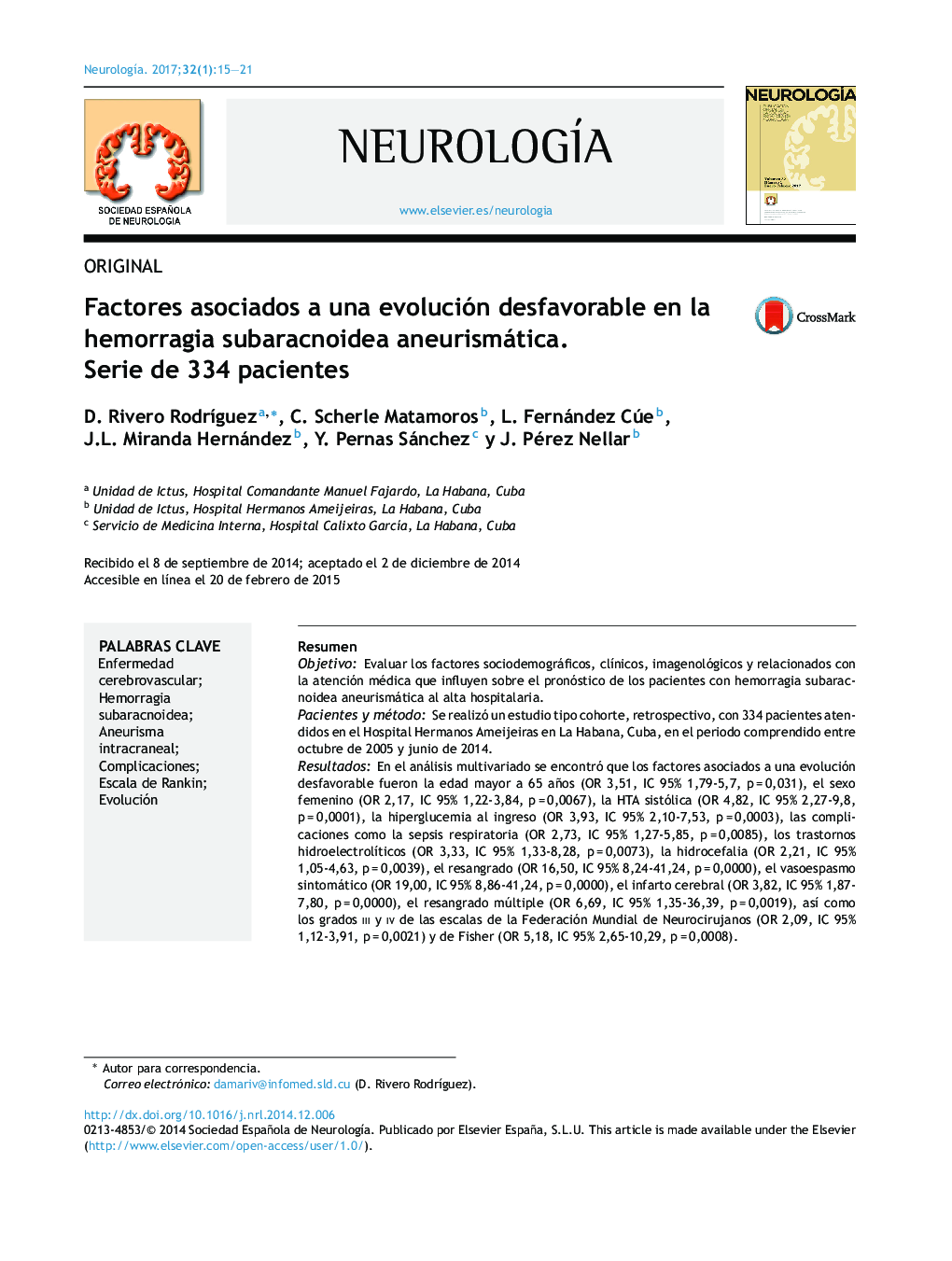| کد مقاله | کد نشریه | سال انتشار | مقاله انگلیسی | نسخه تمام متن |
|---|---|---|---|---|
| 5631764 | 1406509 | 2017 | 7 صفحه PDF | دانلود رایگان |
ResumenObjetivoEvaluar los factores sociodemográficos, clÃnicos, imagenológicos y relacionados con la atención médica que influyen sobre el pronóstico de los pacientes con hemorragia subaracnoidea aneurismática al alta hospitalaria.Pacientes y métodoSe realizó un estudio tipo cohorte, retrospectivo, con 334 pacientes atendidos en el Hospital Hermanos Ameijeiras en La Habana, Cuba, en el periodo comprendido entre octubre de 2005 y junio de 2014.ResultadosEn el análisis multivariado se encontró que los factores asociados a una evolución desfavorable fueron la edad mayor a 65 años (OR 3,51, IC 95% 1,79-5,7, p = 0,031), el sexo femenino (OR 2,17, IC 95% 1,22-3,84, p = 0,0067), la HTA sistólica (OR 4,82, IC 95% 2,27-9,8, p = 0,0001), la hiperglucemia al ingreso (OR 3,93, IC 95% 2,10-7,53, p = 0,0003), las complicaciones como la sepsis respiratoria (OR 2,73, IC 95% 1,27-5,85, p = 0,0085), los trastornos hidroelectrolÃticos (OR 3,33, IC 95% 1,33-8,28, p = 0,0073), la hidrocefalia (OR 2,21, IC 95% 1,05-4,63, p = 0,0039), el resangrado (OR 16,50, IC 95% 8,24-41,24, p = 0,0000), el vasoespasmo sintomático (OR 19,00, IC 95% 8,86-41,24, p = 0,0000), el infarto cerebral (OR 3,82, IC 95% 1,87-7,80, p = 0,0000), el resangrado múltiple (OR 6,69, IC 95% 1,35-36,39, p = 0,0019), asà como los grados iii y iv de las escalas de la Federación Mundial de Neurocirujanos (OR 2,09, IC 95% 1,12-3,91, p = 0,0021) y de Fisher (OR 5,18, IC 95% 2,65-10,29, p = 0,0008).ConclusionesLa evolución de la hemorragia subaracnoidea aneurismática está relacionada con la edad, el sexo, el estado clÃnico al arribo a la unidad de ictus, asà como las caracterÃsticas imagenológicas según la escala de Fisher, las cifras de tensión arterial y de glucemia, y las complicaciones como los trastornos hidroelectrolÃticos, la hidrocefalia, el resangrado, el vasoespasmo y el resangrado múltiple.
ObjectiveThis study evaluates care-related sociodemographic, clinical, and imaging factors and influences associated with outcome at discharge in patients with aneurismal subarachnoid haemorrhage.Patients and methodRetrospective cohort study in 334 patients treated at Hospital Hermanos Ameijeiras in Havana, Cuba between October 2005 and June 2014.ResultsLogistic regression analysis determined that the following factors were associated with higher risk of poor outcome: age older than 65 years (OR 3.51, 95% CI 1.79-5.7, PÂ =Â .031), female sex (OR 2.17, 95% CI 1.22-3.84, PÂ =Â .0067), systolic hypertension (OR 4.82, 95% CI 2.27-9.8, PÂ =Â .0001), and hyperglycaemia at admission (OR 3.93, 95% CI 2.10-7.53, PÂ =Â .0003). Certain complications were also associated with poor prognosis, including respiratory infection (OR 2.73, 95% CI 1.27-5.85, PÂ =Â .0085), electrolyte disturbances (OR 3.33, 95% CI 1.33-8.28, PÂ =Â .0073), hydrocephalus (OR 2.21, 95% CI 1.05-4.63, PÂ =Â .0039), rebleeding (OR 16.50, 95% CI 8.24-41.24, PÂ =Â .0000), symptomatic vasospasm (OR 19.00, 95% CI 8.86-41.24, PÂ =Â .0000), cerebral ischaemia (OR 3.82, 95% CI 1.87-7.80, PÂ =Â .000) and multiplex rebleeding (OR 6.69, 95% CI 1.35-36.39, PÂ =Â .0019). Grades of iii and iv on the World Federation of Neurological Surgeons (OR 2.09, 95% CI 1.12-3.91, PÂ =Â .0021) and Fisher scales (OR 5.18, 95% CI 2.65-10.29, PÂ =Â .0008) were also related to poor outcome.ConclusionsOutcome of aneurysmal subarachnoid haemorrhage was related to age, sex, clinical status at admission to the stroke unit, imaging findings according to the Fisher scale, blood pressure, glycaemia and such complications as electrolyte disturbances, hydrocephalus, rebleeding, and multiplex rebleeding.
Journal: NeurologÃa - Volume 32, Issue 1, JanuaryâFebruary 2017, Pages 15-21
